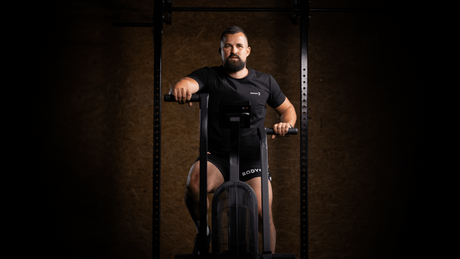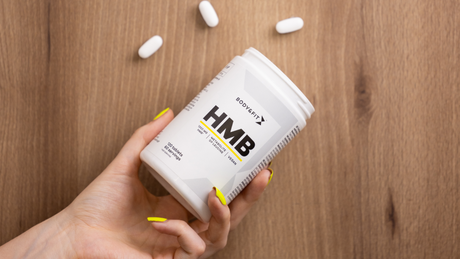If you’re into health & fitness in any way, you’ve probably heard the term ‘bulking’. It’s one of the most common phases athletes, bodybuilders and general keep-fitters might choose to go through. In this blog, we’ll be covering what bulking is, how you can approach it and who it can be useful for, along with some insights and personal experiences from Jesper Rietmeijer.
A certified dietician, personal trainer and online nutrition & health coach, Jesper has been through many different cycles of bulking and tried out many different approaches. So, let’s find out his most important tips and discover how he puts bulking into practice.
WHAT IS BULKING AND HOW DO YOU DO IT?
A bulking phase is when you’re trying to gain muscle and weight by eating more calories than you burn (known as a calorie surplus). Your body can use this excess energy for anabolic events, such as building muscle tissue. Of course, paying attention to your calorie intake is hugely important when bulking, as is getting an adequate amount of protein. A daily amount of 1.4 - 2.2g per kg of bodyweight is ideal to help support muscle maintenance and growth.
Another key factor to consider when bulking is progressive strength training. This is where you continuously stimulate your muscles to adapt to a certain level of resistance, through lifting weights, for example. You then increase the weight, sets or reps each time you work out. Consuming the right amount of food together with progressive strength training will eventually result in strength and muscle gain.

THE DIFFERENT APPROACHES TO BULKING
There are different approaches to bulking, including the dirty bulk, clean bulk, and maingaining. When choosing the type of bulk that’s right for you, it’s important to consider your goal, body type, and general preferences.
THE DIRTY BULK
The dirty bulk is all about eating as much as possible to gain lots of weight and muscle in a short period. Many people eat less nutritious food such as fast food during a dirty bulk — hence the name. While eating these foods may be fun during your bulking phase, the downside is that you’ll probably put on a substantial amount of body fat as well (not to mention the other things unhealthy food does to your body). Every lifestyle should allow some room for less healthy food, but we generally don’t recommend excess amounts even when bulking.
Gaining a large amount of body fat isn’t an issue for all people. Some are genetically built with a low body fat percentage and don’t gain weight and fat that quickly. For these people, a dirty bulk approach might be more suitable compared to other bulking approaches, although just because you don’t put on weight easily, doesn’t mean it’s healthy in the long run.
THE CLEAN BULK
A clean bulk also requires a calorie surplus, but in a more controlled manner. You’re conscious of both the number of calories you eat as well as the types of food. The focus is on reaching your calorie and protein goals in a healthy way, rather than eating unhealthy foods to consume as many calories as possible. This approach allows you to keep fat gain to a minimum while still gaining muscle, which is of course a major advantage. Since you’re in a calorie surplus, you’ll still gain some body fat, but it should be substantially less than during a dirty bulk.
BULKING BY MAINGAINING
Maingaining is eating just a few more calories than you normally would, creating a very small calorie surplus. To do so, you must be conscious about the types and amount of food you eat. You can maingain without tracking calories, but most find it useful to track calories especially at first. The very small calorie surplus keeps the fat gain to a minimum, while it’s still possible to build muscle. The downside of this approach is that it usually takes longer to build the same amount muscle than in a dirty or clean bulk and your overall weight gain will be less. This is most apparent for people that have a hard time gaining weight and muscle. If you’re satisfied with your weight and body fat percentage and simply want to build some more muscle, main-gaining is the way to go.

BULKING BASED ON YOUR BODY TYPE
Your approach to bulking depends largely on your body type and genetics. Body types can be broadly described by 3 different somatotypes based on physical traits. Although many people fit into one of these three types, it’s not a one size fits all. Very often people have traits from multiple somatotypes and it’s even possible to switch from one somatotype to another. Overall, it’s a good guideline for choosing which bulk to go for.
ENDOMORPH AND MUSCLE GAINS
Also known as the ‘easy gainer’. Characterised as having a high body fat percentage, usually with good muscle tone underneath. Endomorphs gain weight and fat easily and have a hard time dropping it. A maingaining approach helps them to keep fat gain to a minimal, if that’s their goal.
MESOMORPH AND MUSCLE GAINS
Mesomorphs are characterised by a more athletic build and gaining muscle relatively easily. For these people, a clean bulk is most suitable. Although maingaining is appropriate, too, especially if you want to minimise fat gain and are okay with a more slow and sustainable bulking approach. Since people with a mesomorph body type don’t have the hardest time gaining muscle mass, an aggressive dirty bulk is unnecessary.
ECTOMORPH AND MUSCLE GAINS
An ectomorph is also known as a ‘hard gainer’. Characterised as skinny, having a low body fat percentage, little muscle and a really hard time gaining weight. A clean or dirty bulk suits these people best. They can get away with consuming many calories, as body fat gain is not a big concern. They can also approach their bulk aggressively. The struggle of getting in enough calories to gain muscle and weight can be real. For these ‘hard gainers’, Jesper has some tips:
· Try to eat frequently, around 6-8 times a day. That includes bigger meals and calorie-heavy snacks in between. The more frequently you eat the more calories you can get in.
· Eat calorie dense and (mostly) healthy foods. Try to eat a lot of calorific foods that still have a high nutritional value, such as nuts, seeds, oils, nut butters, pasta, avocados, salmon, mueslis, weight gainers, protein bars and muesli bars.
· It’s okay to eat some ‘unhealthy’ foods every now and then. Candy bars, pastries or hamburgers are very calorie-dense foods that can help you reach a calorie surplus. Since these foods are less nutritious, try not to eat them too often. A good rule to follow is eating healthy 80% of the time and enjoying less healthy food 20% of the time.
· Prep your food (read more about meal prepping here). Make sure you always have meals and snacks on hand. These can be fully prepped meals you cook before, or snacks like weight gainers, protein bars, muesli bars, and nuts. Thinking ahead makes it easier to stick to your calorie and protein goals.

THIS IS WHAT BULKING BY MAINGAINING LOOKS LIKE
Jesper: “I eat around 2800-3000 calories a day in a maingaining phase, with 180-210 g of protein. Usually, I don’t worry too much about the amount of fats and carbohydrates, but most of the calories tend to come from carbs. His daily macronutrient intake is roughly as follows:
Proteins: 25-30%
Carbohydrates: 40-50%
Fats: 25-30%
So, what does Jesper eat in a day? We asked him to put together a typical daily meal plan for maingaining, including snacks, and this is what he gave us:
Meal 1: Overnight oats (60g), with 1 scoop Body&Fit Whey Isolate XP, 200ml almond milk, 1 banana, 10g sultanas, cinnamon and Body&Fit Natural Flavouring Drops.
Pre workout: Body&Fit BF10 Pre-workout with Body&Fit Creatine and Citrulline Malate.
Meal 2: Two bread rolls with three whole eggs, 20 g of cheese and some ketchup + tomato, pickle and cucumber salad.
Snacks: Divided throughout the day, a couple of protein bars, such as Body&Fit Perfection Bar Deluxe or Smart Bar Crunchy, along with some fruit.
Meal 3: Rice (cooked, 300g) with 150g of chicken and lots of vegetables (400 to 500g). A low-calorie sauce adds flavour to a meal like this.
Pre-bed snack: 300g of cottage cheese with some puffed wheat, a quarter scoop of Body&Fit casein, 50g of blueberries and 10g of sultanas. Also a protein bar and a bag of Body&Fit Smart Protein Chips, or fruit.
On a typical day, Jesper estimated he would take in about the following calories and macronutrients:
3020 kcal
205g protein
400g carbohydrates
60g fats
It’s important to remember that everyone has a unique body and can always adapt their own approach. We hope the information in this blog will give you the tools you need to start a successful bulk yourself. As always, we’re happy to help you find the right products and routine. Feel free to chat to our nutrition experts via our customer service channels or get in touch on social media, where you can find more expert advice and daily inspiration for every health & fitness goal. More tips from Jesper? Check out his Instagram here.
#FINDYOURFIT




